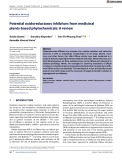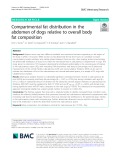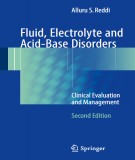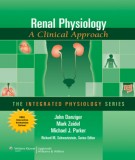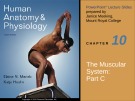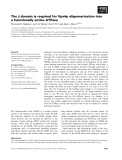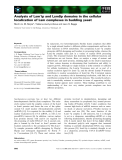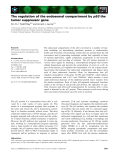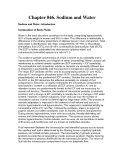
The body’s compartments
-
Oxidoreductases (ORases) are enzymes that catalyze oxidation and reduction reactions in cells or extracellular compartments of the body. Genetic mutations and other factors that affect ORase activity have been implicated in a range of diseases, especially inherited metabolic disorders. Aldose reductase, sorbitol dehydrogenase, xanthine oxidoreductase are the ORases with relevance to diabetes pathology.
 7p
7p  dianmotminh02
dianmotminh02
 03-05-2024
03-05-2024
 3
3
 1
1
 Download
Download
-
Microplastics are nowadays considered ubiquitous pollutants since they have been found widespread in all environmental compartments, particularly in aquatic systems. In urban water bodies, municipal wastewater discharges and overflows of combined storm and wastewater drains are the sources of microplastic pollution.
 17p
17p  viisac
viisac
 15-09-2023
15-09-2023
 5
5
 4
4
 Download
Download
-
Adipose tissue may have different metabolic and endocrine functions depending on the region of the body in which it is located. While visceral or intra-abdominal fat has been found to contribute to leptin concentrations, insulin resistance and obesity-related diseases, there are only a few imaging studies documenting the preferential distribution of body fat to either the intra-abdominal or subcutaneous compartments in dogs.
 11p
11p  vigalileogalilei
vigalileogalilei
 28-02-2022
28-02-2022
 8
8
 1
1
 Download
Download
-
Several studies have verified body fat distribution in association with pulmonary function (PF), mainly waist circumference, but few have used measures able to distinguish abdominal fat compartments. The present study aims to verify the association of visceral adipose tissue (VAT) and subcutaneous adipose tissue (SAT) with PF measures.
 8p
8p  vimaine2711
vimaine2711
 26-03-2021
26-03-2021
 5
5
 2
2
 Download
Download
-
Bio-enhancers such as piperine, curcumine, ginger and cow urine distillate are being seen as important adjuvant drugs to combat antimicrobial resistance and to increase efficiency of antimicrobial agents. Cow urine distillate is one of the important bio-enhancer easily available with farmer. The disposition kinetics was aimed to assess the pharmacokinetic alteration in profile of moxifloxacin, a third generation fluoroquinolone anti-microbial agent. Moxifloxacin was administered at the dose rate of 5 mg.
 9p
9p  chauchaungayxua3
chauchaungayxua3
 07-02-2020
07-02-2020
 12
12
 1
1
 Download
Download
-
Marbofloxacin is a third generation quinolone developed exclusively for veterinary use. The disposition kinetic profile of marbofloxacin was generated after a single intravenous bolus injection in male Sahiwal calves (n = 5) at the dose level of 2 mg.kg-1 body weight. Marbofloxacin concentrations in plasma were determined by microbiological assay using Escherichia coli MTCC 443 as the test organism. The plasma concentration–time profile following intravenous administration was best described by a two-compartment open model. The plasma drug concentration ≥ 0.12 μg.ml-1 was detected at 24 h.
 8p
8p  chauchaungayxua3
chauchaungayxua3
 07-02-2020
07-02-2020
 13
13
 1
1
 Download
Download
-
(BQ) Part 1 of the document Clinical evaluation and management in fluid, electrolyte and acid base disorders has contents: Body fluid compartments, interpretation of urine electrolytes and osmolality, renal handling of nacl and water, disorders of water balance - physiology,... and other contents. Invite you to refer.
 279p
279p  thuongdanguyetan05
thuongdanguyetan05
 05-07-2019
05-07-2019
 34
34
 1
1
 Download
Download
-
(BQ) Part 1 of the document Renal physiology - A clinical approach presents the following contents: Getting started-The approach to renal physiology, the body’s compartments-The distribution of fluid, review questions, clearing waste-glomerular filtration.
 112p
112p  thangnamvoiva3
thangnamvoiva3
 28-06-2016
28-06-2016
 43
43
 2
2
 Download
Download
-
The muscular system (part c). In this chapter, you will learn: Muscles crossing the shoulder joint, rotator cuff anatomy and function, movement at the glenohumeral joint, muscles crossing the elbow joint, muscles of the forearm, muscles of the forearm: anterior compartment, muscles of the forearm: posterior compartment,...and other contents.
 45p
45p  tangtuy07
tangtuy07
 02-04-2016
02-04-2016
 55
55
 2
2
 Download
Download
-
In the past it has been postulated that the metabolism of hump fat could supply water to the fluid compartments when the camel is water deprived. While water is a by-product of carbohydrate and fat metabolism, it is now known that the act of gaining the oxygen required would cause the loss of more water than would be gained. Also, cellular metabolism creates heat and the camel’s survival strategy, especially during periods of water deprivation, is to reduce metabolic rate and hence heat production and water loss.
 165p
165p  conduongdinhmenh
conduongdinhmenh
 07-05-2013
07-05-2013
 43
43
 11
11
 Download
Download
-
The summer/winter difference in plasma volume may be related to the regularly observed summer fall in red blood cell values and total protein. In a fully dehydrated camel with 65% body water, alimentary water has been reported as 12%, which is similar to the figure for tropical cattle. The total water content of the camel is considerably greater in hot dry weather (up to 75%) than in cooler periods (down to 50%), which indicates its physiological water conserving capability.
 0p
0p  conduongdinhmenh
conduongdinhmenh
 07-05-2013
07-05-2013
 44
44
 9
9
 Download
Download
-
Endocytic and biosynthetic trafficking pathways to the lysosome⁄vacuole converge at the prevacuolar endosomal compartment. During transport through this compartment, integral membrane proteins that are destined for delivery to the lysosome⁄vacuole lumen undergo multivesicular body (MVB) sorting into internal vesicles formed by invagination of the endo-somal limiting membrane.
 17p
17p  inspiron33
inspiron33
 26-03-2013
26-03-2013
 32
32
 3
3
 Download
Download
-
In eukaryotes, two heteroheptameric Sm-like (Lsm) complexes that differ by a single subunit localize to different cellular compartments and have dis-tinct functions in RNA metabolism. The cytoplasmic Lsm1–7p complex promotes mRNA decapping and localizes to processing bodies, whereas the Lsm2–8p complex takes part in a variety of nuclear RNA processing events.
 16p
16p  vinaphone15
vinaphone15
 25-02-2013
25-02-2013
 40
40
 1
1
 Download
Download
-
The endosomal compartment of the cell is involved in a number of func-tions including: (a) internalizing membrane proteins to multivesicular bodies and lysosomes; (b) producing vesicles that are secreted from the cell (exosomes); and (c) generating autophagic vesicles that, especially in times of nutrient deprivation, supply cytoplasmic components to the lysosome for degradation and recycling of nutrients.
 12p
12p  viettel02
viettel02
 22-02-2013
22-02-2013
 29
29
 2
2
 Download
Download
-
Sodium and Water: Introduction Composition of Body Fluids Water is the most abundant constituent in the body, comprising approximately 50% of body weight in women and 60% in men. This difference is attributable to differences in the relative proportions of adipose tissue in men and women. Total body water is distributed in two major compartments: 55–75% is intracellular [intracellular fluid (ICF)], and 25–45% is extracellular [extracellular fluid (ECF)]. The ECF is further subdivided into intravascular (plasma water) and extravascular (interstitial) spaces in a ratio of 1:3.
 35p
35p  socolanong
socolanong
 25-04-2012
25-04-2012
 44
44
 4
4
 Download
Download
-
Pathogenesis and Immunology Diphtheria toxin, produced by toxigenic strains of C. diphtheriae, is the primary virulence factor in clinical disease. The toxin is synthesized in precursor form; is released as a 535-amino-acid, single-chain protein; and has an LD50 of ~100 ng/kg of body weight. The toxin is produced in the pseudomembranous lesion and is taken up into the bloodstream, through which it is distributed to all organ systems.
 5p
5p  colgate_colgate
colgate_colgate
 21-12-2010
21-12-2010
 74
74
 3
3
 Download
Download
-
Harrison's Internal Medicine Chapter 46. Fluid and Electrolyte Disturbances Sodium and Water Sodium and Water: Introduction Composition of Body Fluids Water is the most abundant constituent in the body, comprising approximately 50% of body weight in women and 60% in men. This difference is attributable to differences in the relative proportions of adipose tissue in men and women. Total body water is distributed in two major compartments: 55–75% is intracellular [intracellular fluid (ICF)], and 25–45% is extracellular [extracellular fluid (ECF)].
 5p
5p  ongxaemnumber1
ongxaemnumber1
 29-11-2010
29-11-2010
 83
83
 8
8
 Download
Download
-
4.35 and 4.36, respectively. Shown in Fig. 4.39, the impulses of the two vehicles between 0 to 20 ms are mainly due to the stiff front rail design and damping of the body mount. They are not considered the decelerations of the main body of the truck. It will be shown in Chapter 5 that the impulsive transient responses at the beginning of the crush are mainly controlled by the damping characteristics of the body mounts, positioned between the compartment (or cab) and frame. The steady state compartment responses, where the peak body deceleration occurs, are attributed mainly to and...
 20p
20p  hiruscar
hiruscar
 19-10-2010
19-10-2010
 68
68
 8
8
 Download
Download
CHỦ ĐỀ BẠN MUỐN TÌM








